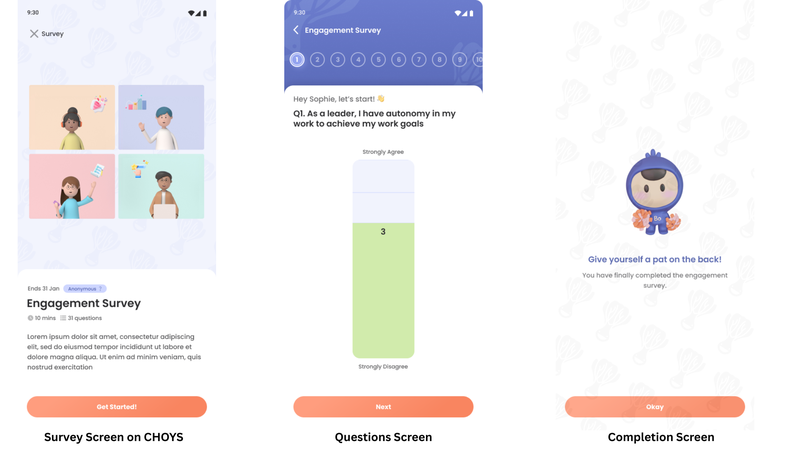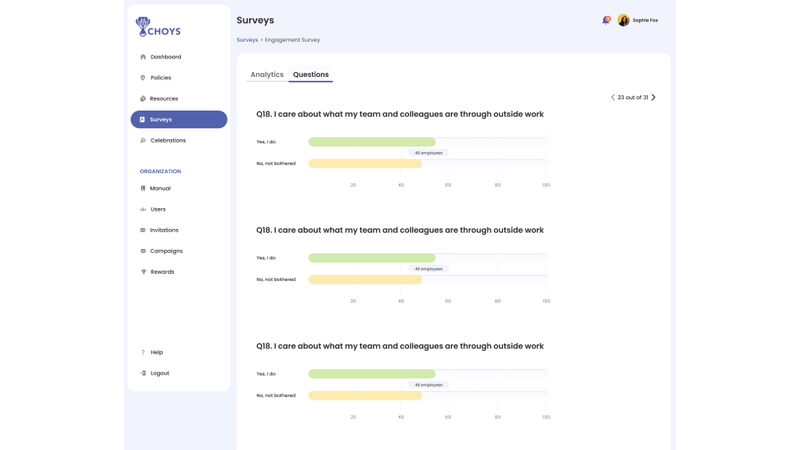Employee Engagement Survey: What to Ask, Why It Matters, and How to Act

Your financials might look great on paper. Revenue is up, and KPIs are being hit. But then you get three resignation letters in one week, and no one saw it coming. What happened? Chances are, no one asked.
That’s where an employee engagement survey comes in. Not a pulse check from 2020. Not a “How’s everyone doing?” at the town hall. A real, well-designed, anonymous survey that digs into how your people actually feel about their work, their growth, their managers, and their future with your company.
What the data says:
According to Gallup, only 23% of employees worldwide were engaged in 2024. That means more than three out of four people in the average company are coasting, checked out, or actively disengaged. The cost? A staggering $8.9 trillion in lost productivity globally.
But here’s the opportunity: organisations that run regular, meaningful employee engagement surveys and act on the feedback? They outperform peers by 147% in earnings per share. This guide covers everything you need to know about employee engagement surveys.
What Is an Employee Engagement Survey?
An employee engagement survey is a tool that helps you listen at scale. It measures how connected, motivated, and committed your employees feel to their work and your company’s mission. And when done right, it doesn’t just give you data, it sparks change.
Let’s be clear: this isn’t a general satisfaction survey. Employee engagement goes deeper. It’s about how people think, feel, and act at work. Are they just checking boxes? Or are they contributing, solving, and pushing the business forward?
A good survey on employee engagement helps uncover what’s driving (or dragging down) that energy. It includes both quantitative data, such as Likert scale questions, and qualitative insights like open-text responses. Combined, they offer a clearer picture of what’s working and what’s broken.
Also read: The Link Between Employee Wellbeing and Engagement
Why Employee Engagement Surveys Matter
You can’t fix what you can’t see. Running regular employee engagement surveys gives HR leaders and managers a real-time view of team sentiment. Not guesses. Not gossip. Actual feedback.
And that feedback matters. Here's why:
- Engaged teams are more productive: Companies with high engagement see a 21% boost in productivity and 22% higher profitability, according to Gallup.
- Turnover drops: When people feel heard and valued, they’re less likely to leave. Simple as that.
- Culture improves: The Leadership role is crucial in employee engagement. Regular surveys to measure employee engagement create a feedback loop where employees feel seen, and leaders stay accountable.
- Leaders get a roadmap: You’ll know exactly where to focus, be it recognition, growth opportunities, workload, or communication.
Still think it’s just a “nice to have”? Consider this: actively disengaged employees cost U.S. companies up to $550 billion annually in lost productivity. That’s not just expensive, it’s avoidable.
What to Ask: High-Impact Employee Engagement Survey Questions
You don’t need 100 questions to understand your workforce. But you do need the right ones.
The best employee engagement survey questions are clear, specific, and designed to spark real insight. They go beyond vague satisfaction ratings and get to the root of what matters: connection, motivation, and growth.
Here’s how to structure your questions around the key drivers of engagement:
1. Job Satisfaction & Motivation
- “Do you feel excited about coming to work?”
- “Are you proud to work here?”
- “Do you feel your work makes a difference to the company’s goals?”
2. Career Growth & Development
- “Do you see a clear path for advancement at this company?”
- “Has someone discussed your professional goals with you in the last six months?”
3. Recognition & Feedback
- “In the past week, have you received recognition for your work?”
- “Do you feel appreciated for your contributions?”
4. Leadership & Trust
- “Do you trust the senior leadership team to make the right decisions?”
- “Does your manager support your success?”
5. Work Environment & Resources
- “Do you have the tools and resources you need to do your job well?”
- “Is your workload manageable?”
6. Company Alignment & Purpose
- “Do you understand how your work supports the company’s mission?”
- “Does our purpose as a company inspire you?”
7. Retention & Intent to Stay
- “Do you see yourself working here a year from now?”
- “Have you considered leaving in the past three months?”
Also read: The 5Cs of Employee Engagement
How to Design a Survey That Gets Honest, Actionable Feedback
You can have the best survey questions about employee engagement, but if your design is clunky or confusing, response rates will tank, and trust may take a hit.
Here’s how to design a smart, human-centred survey on employee engagement that gets real results:
Keep It Simple
No one wants to take a test. Aim for 30 to 50 questions max. Group them by theme (e.g., leadership, growth, culture), and keep the language casual and jargon-free. If a question needs a footnote to explain it, rewrite it.
Use a Consistent Rating Scale
The 5-point Likert scale (from “Strongly Agree” to “Strongly Disagree”) is a proven winner. It’s familiar, quick to complete, and easy to analyse.
Include a Few Open-Ended Questions
Numbers show you the trend. Words show you the why.
- “What’s one thing we could do to improve your experience here?”
- “What do you enjoy most about working here?”
Not everyone will answer, but those who do often give your most valuable insights.
Keep It Anonymous and Say So
Employees won’t be honest if they think there’s a risk. Make anonymity crystal clear. If you’re using a third-party employee engagement survey provider, highlight that. Trust leads to truth.
Pick the Right Timing
Avoid survey fatigue. Don’t run surveys during crunch periods, holidays, or big organisational changes unless you’re surveying about those changes specifically.
Test Before You Launch
Share your draft with a small group first. Make sure it’s clear, inclusive, and not overly long. Fix anything that’s confusing or ambiguous.
Choosing the Right Employee Engagement Survey Provider
Designing and running a survey might seem simple on the surface. But if you've ever tried to juggle 30+ questions, scale them across departments, ensure anonymity, and extract meaningful insights, you know it's anything but easy.
That’s where CHOYS can help you.
We’re not just another employee engagement survey provider. We’re your partner in actually moving the needle on engagement, not just measuring it.

Here is How CHOYS Works
We do the heavy lifting
You don’t need to stress over building a survey from scratch. CHOYS gives you a ready-to-go, expert-backed survey with all the right questions already built in. We cover everything from morale and motivation to career development and culture.
Tailored insights from real experts
Once your survey closes, our team doesn’t just hand you a dashboard and say, “good luck.” We dive into your results and work with you to create a custom action plan based on your team’s real feedback to improve employee engagement.
No guesswork, no gaps
From setup to analysis, CHOYS takes care of it all, so you can focus on what really matters: improving the employee experience.
Built for humans, not just HR
Clean design. Mobile-ready. Anonymous. Simple. Take a look at our interface, your team won’t dread taking this survey (see image above).
Here is how it looks from the admin portal side of CHOYS:

After the Survey: How to Turn Feedback Into Action
Let’s be honest: a survey without follow-up is worse than no survey at all.
Nothing kills trust faster than asking for input and then doing nothing with it.
Once you’ve run your employee engagement survey, the next steps are where the real impact happens. Here’s how to turn that pile of data into meaningful change:
- Share the Results: Don’t hide the numbers in an internal deck only a few managers see. Share the big takeaways across your teams. Even the tough ones.
- Prioritise What Matters Most: You might uncover ten areas that need work. Don’t try to fix them all at once. Focus on the two or three themes that impact the most people or link directly to retention and performance
- Create a Simple Action Plan: Break it down. What are you improving? Who owns it? What’s the timeline? When will you check back in?
- Close the Loop: Circle back in 30, 60, or 90 days. Share what’s been done and what’s coming next.
FAQs
Q: What are employee engagement surveys?
Employee engagement surveys are structured questionnaires used to measure how committed, motivated, and emotionally invested employees are in their work and workplace. It helps you see what’s working and where things are slipping before people start quietly quitting or walking out the door
Q: What questions should I include in an employee engagement survey?
Start with the big stuff. What do you really want to know?
Here are some essential employee engagement survey questions:
- Do you feel excited to come to work most days?
- Is your manager someone you can count on for support?
- Can you see a clear future for your career here?
- Do you feel recognised when you go above and beyond?
- Would you recommend working here to a friend?
Q: How often should we run engagement surveys?
Start with a comprehensive annual survey, then follow up with quarterly pulse checks, shorter, quicker snapshots to track progress and keep the momentum going.
Q: Are employee engagement surveys really anonymous? Should they be?
Yes, and they absolutely should be. If employees don’t feel safe sharing how they feel, the survey’s just a formality.
Q: What’s the best way to increase employee participation in a survey?
Make it easy. Make it short. Make it matter. Here’s what works:
- Be transparent. Tell people why you’re running the survey and what you’ll do with the results.
- Respect their time. Keep it to 10–15 minutes max.
- Follow up. The biggest motivator for future surveys? Showing you acted on the last one
Q: What are some common mistakes to avoid with engagement surveys?
Here are a few big ones to watch out for:
- Too many questions: Nobody wants a 45-minute exam.
- Vague language: Be clear and specific.
- No follow-up: Asking and ignoring is worse than not asking at all.
- Biased wording: Don’t lead people to the “right” answer.
Relevant Blogs:


